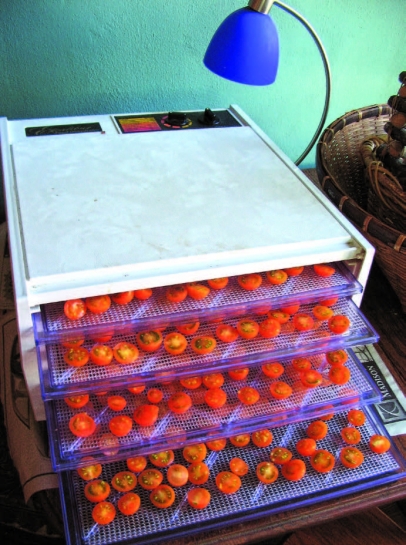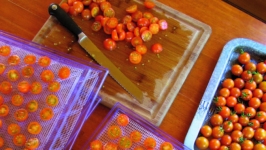Saving the other “Cherry” of summer: CHERRY TOMATOES
The rush is on. The rush of summer produce, that is. Who can resist the plush displays at farmers markets and farm stands throughout the area? There’s no ignoring the over-achieving out- put from our own backyard gardens, either. The question isn’t, “What’s for dinner?” but “How do I get the most out of all this great stuff while the getting is good?”
Take tomatoes. At first, you can’t get enough: You slice and salt them. You drizzle them with vinegar and olive oil. You chuck them with abandon into salads and sandwich- es. But after several batches of gazpacho, nu- merous rounds of bruschetta and countless meals of penne with marinara sauce, they’re still coming at you with breakneck speed. You say you’re not a canner? Or no room in the freezer? Not to worry. Try this: When life gives you too many tomatoes, dry them. Extend the local harvest with a dehydrator.
While I’m typically not into single-use con- traptions that take up shelf space in the base- ment, the five-tray “Excalibur”brand dehydra- tor I bought several years ago has become one of the most useful pieces of kitchen equipment I own. Like most dehydrators, it’s a simple electric machine that uses a low-temperature heating element to remove moisture from food (which is placed on trays inside it) plus a fan and an air vent that blow the warm, moist air out of the appliance.
By removing moisture from local, in-season fruits and vegetables, I get concentrated flavor and nutrition throughout the no-grow months of the year. Reconstituted morels, for exam- ple, produce righteous risottos and deeply delicious beef stews. Dried pears, cherries or peach quarters make sweet, chewy fruit candy. And dried tomatoes make one of the tastiest mid-afternoon snacks around. They also en- rich soups, sauces, salads, dips, pastas and so many other dishes.
Drying food is uncomplicated and undemanding, and unlike can- ning, dehydrating doesn’t involve turning you or your kitchen into a hot mess. The hands-on part—peeling fruit, slicing tomatoes—can be accomplished while watching Masterpiece Theatre or lounging on the front porch, sipping G & Ts. Lay the ingredients on the dehy- drator trays, set the dial to the recommended temperature and your job is basically done — except for the part some hours later when, after transferring the product to an airtight container, you find yourself spending long minutes gazing with satisfaction at summer in a jar.
Even though the process is easy, there are some basics to follow: Always dry a single type of food at once, and, if you’re slicing it, make the slices of even thickness so that they dry evenly. Don’t crowd the pieces; place them on the trays in a single layer without touching each other, so that air can circulate all around.
Follow the temperature guide that’s on or comes with your dehydra- tor; drying at too high a temp can scorch the outside before the inside is dry. Drying times vary greatly and depend on food type, size and shape, so check for doneness every few hours: Remove a couple piec- es of the food item from the dehydrator and let them come to room temperature; if the pieces still have juiciness or a lot of sponginess to them, keep going. Another test is to tap a piece on a table top; if it “clicks,” it’s dry. Completely cool the now-dried food before placing it in containers; these could be plastic bags or tubs or glass canning jars (my favorite, since they show off my creations so agreeably). Store them in a cool, dry place; they can also be frozen.
Rehydrating dried foods is simply a matter of immersing them in hot liquid —water, stock, liqueur, wine, etc., depending on how they will be used — until the item has softened. And whatever you do, don’t through away that liquid! Leftover liquid from reconstituting dried vegetables makes a delicious stock; fruit-based liquid can be chilled and enjoyed as beverage or boiled down to a syrup.
Dehydrating is particularly useful for budget-minded folks because no freezer or canning equipment is required and the finished products need little storage space. Even the dehydrating appliance itself is optional, for most fruits and vegetables can be dried in a regular oven, at its lowest setting with the door slightly open. (If the oven has a convection fan, that’s even better.) Buying your own electric dehydrator won’t break the bank, either; affordable ones can be found or ordered from hardware stores throughout northeastern Wisconsin.
The list of foods I’ve dried includes herbs, mushrooms, chilies and many types of fruit, but perhaps the easiest of all is cherry tomatoes. I simply slice them in half, place them on drying racks and away they go. In fact, when the tomato harvest is at its highest, and farmers market
vendors are a little desperate about the deluge still coming at them, I’ve been known to bargain for extra pints at a reduced price.
No matter how many I have, the Excalibur can handle it.







